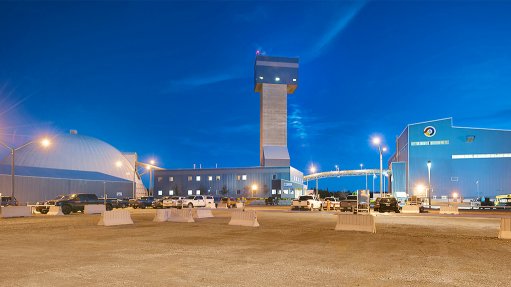
Name: Goldex mine and processing plant.
Location: The Goldex underground mine and processing plant are located in the city of Val-d’Or, in Quebec, Canada.
Controlling Company: Agnico Eagle Mines.
Brief History: The Goldex mine started operating in 2008 as an underground mine exploiting the GEZ zone using high-volume, bulk-tonnage methods with large mining stopes. The mine and mill capacity was increased to 8 200 t/d in 2010. However, owing to water inflow and ground-stability issues, mining in the GEZ was suspended in October 2011. The processing plant closed in the same month and was placed on care and maintenance. In September 2013, the plant resumed operations and now treats ore from the M and E zones.
Following an investigation of the satellite deposits in July 2012, the M and E zones were approved for development as a new operation using largely the same underground infrastructure, but different underground mining methods.
Initial mining of the M and E zones began in September 2013 and commercial production began in the fourth quarter of 2013.
Brief Description: Goldex is located within the prolific Val-d’Or mining district and comprises an underground gold mine and processing facility.
Geology/Mineralisation: The Goldex property is located in the Dubuisson township of Quebec and forms part of the southern Abitibi greenstone belt. The sequence of intermediate to mafic and ultramafic volcanic rocks that underlie the property dips steeply to the north-east. They are intruded by a large table-shaped quartz-diorite body – known as the Goldex granodiorite – that also dips steeply to the north-east. The Cadillac-Larder lake fault zone crosses the southern limit of the Goldex property. Many of the gold mines in the Abitibi greenstone belt are associated with this fault zone.
The Goldex deposit is a large, relatively low-grade body defined by the intensity of stockwork veins and gold grades, rather than by individual veins. Most of the gold at Goldex occurs as microscopic particles associated with pyrite, while the rest is in the form of coarse native gold grains of up to a few millimetres in size. There are several zones of gold mineralisation, with isolated ore-grade intercepts over mineable widths on the property. All of them, except the South zone, are hosted by the Goldex granodiorite.
While the main concentration of gold mineralisation is the GEZ zone, which extends from 500 m to 800 m below surface, Agnico is aggressively exploring the D zone, which is located about 150 m below GEZ. Although not yet fully defined, the D zone is very similar to GEZ in geology, the style of mineralisation and, potentially, size.
The M zone extends from 200 m to about 370 m below surface and dips steeply to the north, with gold-bearing quartz-tourmaline- pyrite veins and veinlets similar to the GEZ. The E zone extends from about 700 m to 850 m below surface, just east of the GEZ. The E zone contains relatively fewer quartz-tourmaline-pyrite veins and veinlets than the GEZ.
Products: Gold.
Reserves: Total proven and probable reserves as at December 31, 2014, were estimated at 7.1-million tonnes grading 1.49 g/t of gold.
Resources: Total measured and indicated resources as at December 31, 2014, were estimated at 33.77-million tonnes grading 1.93 g/t of gold. Inferred resources were estimated at 29.41-million tonnes grading 1.64 g/t of gold.
Mining Method: The selected mining method for the M and E zones is long-hole mining, with primary and secondary stoping, owing to the shape, thickness and orientation of the orebodies. Paste backfill is used to ensure stope stability during mining.
Major Infrastructure and Equipment: The Goldex processing facility starts with a two-stage crushing process, followed by a two-stage grinding circuit that comprises a semiautogenous grinding mill and a ball mill. Most of the ground ore is fed to the gravity circuit that recovers about two-thirds of the gold, which is then smelted on site to form doré bars. Flotation recovers the rest of the gold, producing a gold-bearing pyrite concentrate.
Half of the flotation tails go to the new paste backfill plant.
The pyrite concentrate is thickened and trucked to the LaRonde complex, where it is fed into a dedicated cyanide leach circuit. Gold-bearing leachate from Goldex ore joins the stream of leachate from Lapa ore and is fed directly into the carbon-in-pulp circuit to recover precious metals, which are smelted into doré bars.
Prospects: Exploration and development have been accelerated on Goldex’s Deep Zone, with the goal of outlining a mineable reserve and completion of a technical study by late 2015 or early 2016. Development of the Deep Zone and the nearby Akasaba West deposit have the potential to extend the mine’s life past the current estimated 2017.
Contact: Corporate communications.
Contact Details:
Agnico Eagle,
tel +1 416 847 8669,
fax +1 416 367 4681, and
email media@agnicoeagle.com.